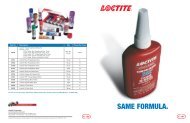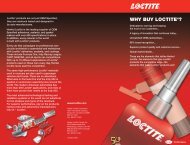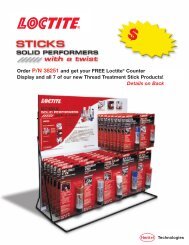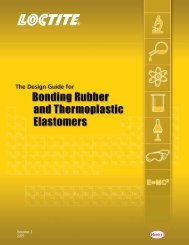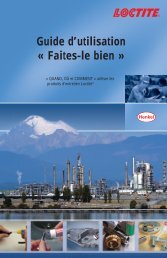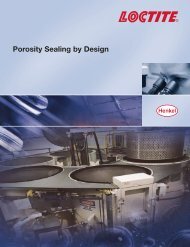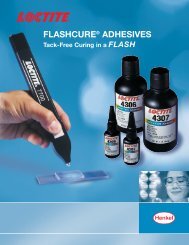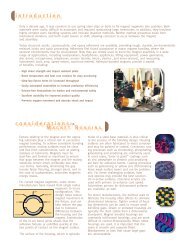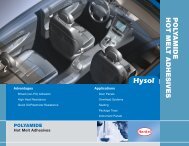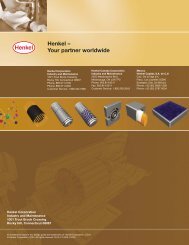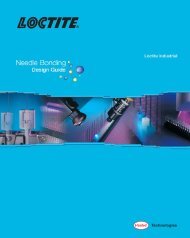Polyethersulfone (PES)ThermoplasticTrade Names• Ultrason• Victrex PESManufacturerBASFVictrex, USAGeneral DescriptionPES is an amor<strong>ph</strong>ous thermoplastic whose backbone is composed ofalternating aromatic groups linked with alternating oxygen and sulfurdioxide groups. PES is primarily used for high temperature applications.Specialty grades available include glass, carbon, stainless steel, andfluorocarbon filled. In 2004, the price of PES ranged approximately from$3.31 to $4.55 per pound at truckload quantities.General PropertiesThe most notable properties of PES are its transparency, goodmechanical properties, and outstanding thermal stability. Unfilled PEShas a useful life of 4 to 5 years at 390°F (199°C) and approximately20 years at 356°F (180°C). Moreover, the mechanical and electricalproperties of PES show a low sensitivity to temperature change andload. In addition, the mechanical properties of PES at elevatedtemperatures can be significantly increased by annealing. PES has alow smoke emission and can withstand long-term exposure to bothair and water at elevated temperatures. PES is chemically resistant tomost inorganic chemicals, greases, ali<strong>ph</strong>atic hydrocarbons, and bothleaded and unleaded gasoline. However, PES is attacked by esters,ketones, methylene chloride, and polar aromatic solvents. Thechemical resistance of PES is lessened by internal stress, but this canbe alleviated by annealing the polymer. Typical of the polysulfonefamily, PES has a low resistance to weathering and is degraded by UVlight, making unfilled PES inappropriate for outdoor use. The majordisadvantage to adhesively joining PES is that PES is extremelysensitive to stress cracking. However, the addition of glass fillers, theuse of adhesive accelerators and/or annealing PES greatly increasesits resistance to stress cracking.Typical Properties of Polyethersulfone (PES)American EngineeringProcessing Temperature 675°F to 700°F 357°C to 371°CLinear Mold Shrinkage 0.001 to 0.006 in./in. 0.001 to 0.006 cm/cmMelting Point 440°F to 460°F 227°C to 238°CDensity 91.8 to 99.9 lb./ft. 3 1.47 to 1.60 g/cm 3Tensile Strength, Yield 13.0 to 21.0 lb./in. 2 x 10 3 9.1 to 14.8 kg/cm 2 x 10 2Tensile Strength, Break 11.9 to 23.6 lb./in. 2 x 10 3 8.4 to 16.6 kg/cm 2 x 10 2Elongation, Break 2.0 to 4.3% 2.0 to 4.3%Tensile Modulus 5.9 to 13.5 lb./in. 2 x 10 5 4.1 to 9.5 kg/cm 2 x 10 4Flexural Strength, Yield 17.9 to 29.5 lb./in. 2 x 10 3 12.6 to 20.7 kg/cm 2 x 10 2Flexural Modulus 3.4 to 13.0 lb./in. 2 x 10 5 2.4 to 9.1 kg/cm 2 x 10 4Compressive Strength 15.9 to 21.3 lb./in. 2 x 10 3 11.2 to 15.0 kg/cm 2 x 10 2Izod Notched, R.T. 1.0 to 1.6 ft.-lb./in. 5.3 to 8.6 kg cm/cmHardness R120 - R123 Rockwell R120 - R123 RockwellThermal Conductivity 1.3 to 2.9 BTU-in./hr.-ft. 2 -°F 0.19 to 0.42 W/m-°KLinear ThermalExpansionDeflection Temperature@ 264 psiDeflection Temperature@ 66 psiContinuousService Temperature1.2 to 3.3 in./in.-°F x 10 -5 2.2 to 5.9 cm/cm-°C x10 -5400°F to 460°F 204°C to 238°C420°F to 460°F 216°C to 238°C350°F to 390°F 177°C to 199°CDielectric Strength 370 to 600 V/10 -3 in. 1.5 to 2.4 V/mm x 10 4Dielectric Constant@ 1 MHzDissipation Factor@ 1 MHzWater Absorption,24 hr.SI3.5 to 4.2 3.5 to 4.20.006 to 0.010 0.006 to 0.0100.29 to 0.41% 0.29 to 0.41%Typical Applications• Electrical – Multipin connectors, coil formers,printed circuit boards• Miscellaneous – Radomes, pump housings, bearing cages,hot combs, medical trays48The <strong>Loctite</strong> ® Design Guide for Bonding Plastics, <strong>Volume</strong> 4
ADHESIVE SHEAR STRENGTH(psi)(MPa)PolyethersulfoneUNFILLED RESIN5 rmsROUGHENED24 rmsLUBRICANT9% Polymist F510INTERNAL MOLDRELEASE0.5% Mold Wiz 55PVFILLER17% 497 FiberglassCOLORANT0.5% Yellow 55-21007POLYSULFONEUdedl courtesy of AmocoPerformance Products<strong>Loctite</strong> ® 380 Black Max ® Instant Adhesive,Rubber Toughened6504.5185012.89506.66504.5175012.16504.56504.5Udel P-1700 produced by Solvay Advanced Polymers 11 rms Ultrason E2010 by BASF<strong>Loctite</strong> ® 401 Prism ® Instant Adhesive,Surface InsensitiveMEDICAL: <strong>Loctite</strong> ® 4011 Prism ®Instant Adhesive, Surface Insensitive<strong>Loctite</strong> ® 401 Prism ®<strong>Loctite</strong> ® 770 Prism ® PrimerMEDICAL: <strong>Loctite</strong> ® 4011 Prism ® /<strong>Loctite</strong> ® 7701 Prism ® Primer<strong>Loctite</strong> ® 414 Super Bonder ®Instant Adhesive, General Purpose<strong>Loctite</strong> ® 330 Depend ® Adhesive,Two-Part No-Mix Acrylic<strong>Loctite</strong> ® 3105 Light Cure Adhesive,MEDICAL: <strong>Loctite</strong> ® 3311 Light Cure Adhesive<strong>Loctite</strong> ® 3340 Light Cure Adhesive,UV Cationic Epoxy<strong>Loctite</strong> ® 4305 Flashcure ® Light Cure AdhesiveFLUORESCENT: <strong>Loctite</strong> ® 4307 Flashcure ®Light Cure Adhesive<strong>Loctite</strong> ® H3000 Speedbonder Structural Adhesive, General Purpose<strong>Loctite</strong> ® H4500 Speedbonder Structural Adhesive, Metal Bonder<strong>Loctite</strong> ® 3030 Adhesive, Polyolefin Bonder<strong>Loctite</strong> ® E-00CL Hysol ® Epoxy Adhesive,Low Odor<strong>Loctite</strong> ® E-90FL Hysol ® Epoxy Adhesive,Flexible<strong>Loctite</strong> ® E-30CL Hysol ® Epoxy Adhesive,Glass BonderMEDICAL: <strong>Loctite</strong> ® M-31CL Hysol ®Epoxy Adhesive, Glass Bonder<strong>Loctite</strong> ® E-20HP Hysol ® Epoxy Adhesive,Fast SettingMEDICAL: <strong>Loctite</strong> ® M-21HP Hysol ®Epoxy Adhesive, Fast Setting<strong>Loctite</strong> ® E-214HP Hysol ® Epoxy Adhesive,High Strength<strong>Loctite</strong> ® Fixmaster ® High Performance Epoxy<strong>Loctite</strong> ® 1942 Hysol ® Hot Melt Adhesive,EVA Based<strong>Loctite</strong> ® 3651 Hysol ® Hot Melt Adhesive,Polyolefin<strong>Loctite</strong> ® 7804 Hysol ® Hot Melt Adhesive160011.01501.09506.62501.7305021.02001.4>2600 >17.9 10006.96004.1200013.84503.16004.16504.56504.5170011.710006.92001.41000.71000.7160011.011007.612508.62501.7305021.08505.96004.17004.88005.5235016.25003.51501.09506.62501.7380026.2160011.0185012.8190013.111507.9305021.08505.94503.1295020.35503.8305021.0160011.01501.07004.89006.2305021.0Adhesive Performance<strong>Loctite</strong> ® 3105 Light Cure Adhesive consistently achieved the highest bond strengths on PES, while <strong>Loctite</strong> ®4305 Flashcure ® Light Cure Adhesive achieved substrate failure at a lower bond strength. <strong>Loctite</strong> ® 401 Prism ® and 414 Super Bonder ® Instant Adhesives, <strong>Loctite</strong> ® 3030 Adhesive, <strong>Loctite</strong> ® E-214HP Hysol ®Epoxy Adhesive, <strong>Loctite</strong> ® 3631 Hysol ® Hot Melt Adhesive, and <strong>Loctite</strong> ® Fixmaster ® High Performance Epoxyall developed significant bond strength on unfilled PES. The only statistically significant difference betweenthe bondability of unfilled PES and polysulfone was that <strong>Loctite</strong> ® 330 Depend ® Adhesive achieved higher,statistically significant bond strengths on the polysulfone than on the unfilled PES.Surface TreatmentsSurface roughening caused either no effect or a statistically significant increase in the bond strengthsachieved on PES. The use of <strong>Loctite</strong> ® 770 Prism ® Primer, in conjunction with <strong>Loctite</strong> ® 401 Prism ® InstantAdhesive, or <strong>Loctite</strong> ® 4011 Prism ® Medical Device Instant Adhesive with <strong>Loctite</strong> ® 7701 Prism ® Primer,caused a statistically significant decrease in the bondability of both PES and polysulfone.Other Important Information• PES and polysulfone are extremely sensitive to stress cracking caused by exposure to uncuredcyanoacrylate adhesives, so any excess adhesive should be removed from the surfaceimmediately, and cyanoacrylate accelerators should be used whenever possible.• PES and polysulfone are compatible with acrylic adhesives, but can be attacked by theiractivators before the adhesive has cured. Any excess activator should be removed from thesurface immediately.• PES and polysulfone are incompatible with anaerobic adhesives.• Surface cleaners: isopropyl alcohol, <strong>Loctite</strong> ® ODC-Free Cleaner & Degreaser.<strong>Loctite</strong> ® 3631 Hysol ® Hot Melt Adhesive,Urethane<strong>Loctite</strong> ® U-05FL Hysol ® Urethane Adhesive,High Strength<strong>Loctite</strong> ® Fixmaster ® Rapid Rubber RepairOEM: <strong>Loctite</strong> ® U-04FL Hysol ®Urethane Adhesive, Fast Setting<strong>Loctite</strong> ® 5900 ® Flange Sealant,Heavy Body RTV Silicone14009.76004.12501.71501.0NOTES: The force applied to the tests specimens exceededthe strength of the material resulting in substrate failurebefore the actual bond strength achieved by theadhesive could be determined.The addition of the indicated additive (or surfaceroughening) caused a statistically significant decrease inthe bond strength within 95% confidence limits.The addition of the indicated additive (or surfaceroughening) caused a statistically significant increase inthe bond strength within 95% confidence limits.The <strong>Loctite</strong> ® Design Guide for Bonding Plastics, <strong>Volume</strong> 4 49



